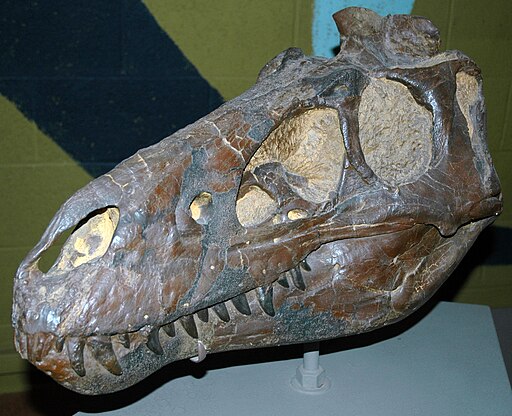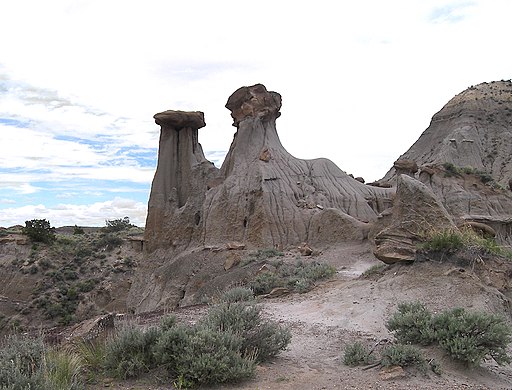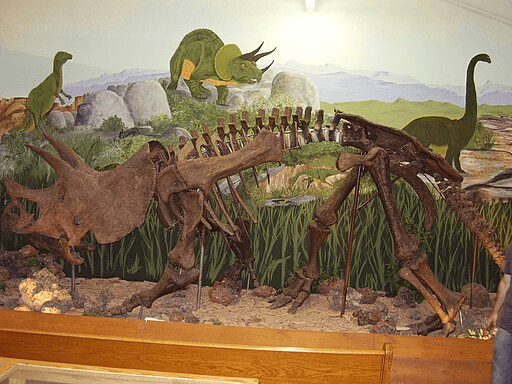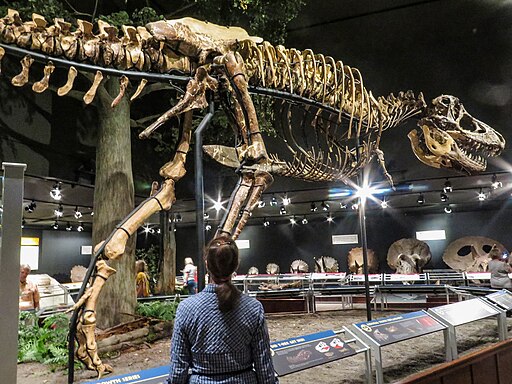What is the Montana Dinosaur Trail?
The Montana Dinosaur Trail is a 14-stop dinosaur-themed journey across Montana, stretching from Bynum to Ekalaka. It’s one of the most immersive experiences available for learning about the elusive history of the giants that once roamed present-day Montana.
The stops along the route offer interactive exhibits, unique programs, and even field digs.
Read on for a map of the Montana Dinosaur Trail and a detailed description of each stop. Plus, find answers to the most commonly asked questions about the route.
How many stops are along the Montana Dinosaur Trail?
There are 14 stops on the Montana Dinosaur Trail, including museums and a state park, The entire trail spans from Ekalaka in eastern Montana to Bynum in western Montana. You may start your route from any of the 14 stops and continue on as you please.
Along the route lie some of the world’s most renowned paleontologists and prehistoric discoveries of the dinosaur era, many of which took place in Montana.
The location of Jack Horner’s discovery of the first dinosaur eggs and the place where the first T. Rex fossil was discovered are two examples.
How long does it take to do the dinosaur trail?
It can take up to a week to see each site on the Montana Dinosaur Trail, depending on how much time you spend at each stop.
Find each stop on the Montana Dinosaur Trail map below, followed by a list of the 14 stops with details about each one.
We start from Ekalaka, which is on the eastern Montana Dinosaur Trail, and end at the Museum of the Rockies in Bozeman, in the central region of the state.
Montana Dinosaur Trail Map
1. Carter County Museum

306 N. Main St.
Ekalaka, MT 59324
406-775-6886
Admission: Free
The Carter County Museum in Ekalaka sits at a unique place on the Montana Dinosaur Trail. Dating back to 1936, it became the first county museum in the state to feature dinosaur fossils.
Ekalaka has been at the center of numerous discoveries for over 100 years and, today, it hosts the Annual Dino Shindig, a yearly event in which scientists speak to the community about their work in the area.
Today, the museum features numerous mounts and casts of various species from the area, including:
- Edmontosaurus annectens
- Triceratops
- Pachycephalosaur
- Plesiosaur
- Ankylosaur
- Pterosaur
- Mosasaur
- The most complete fossil of a juvenile T. Rex
Interesting fact
The Carter County Museum features a giant Hadrosaur on display, one of five ever discovered in the U.S.
Two others, located at the American Museum of Natural History in New York City, were found just west of Ekalaka.
2. FRONTIER GATEWAY MUSEUM
201 State St.
Glendive, MT 59330
406-377-8168
Admission: Free
The Frontier Gateway Museum sits in the heart of the Hell Creek Formation, an area rich in Montana dinosaur fossil discoveries. The museum features exhibits of frontier life and dinosaur discoveries in the area.
The outdoor exhibits include a blacksmith shop, buggy shed, fire hall, vintage farm machinery, a log cabin, and a frontier schoolhouse with original furniture.
Inside exhibits include more historic artifacts from life on the western frontier, plus a wealth of Montana dinosaur fossils, including a full-size skeleton cast of a local Struthiomimus named “Margie”, as well as a Stegoceras, Thescelosaurus, Triceratops, Hadrosaurs, and aquatic and plant fossils.
Interesting fact
Sauropods grew to be over 100 ft (30 m) long and weighed more than 60 tonnes. However, their eggs were no bigger than a soccer ball.
3. MAKOSHIKA STATE PARK

1301 Snyder Avenue
Glendive, MT 59330
406-377-6256
Admission:
- Non-resident entrance fee – $8 per vehicle; $4 walk-in, bike-in or bus
- Camping – ranges from $4-$34 per night depending on the season
Just southeast of Glendive lies a peculiar and devastatingly beautiful region of Montana called the Badlands, which encompasses Montana’s largest state park, Makoshika State Park. In Lakota, Makoshika means ‘bad land’.
The territory of the park lies within the Hell Creek Formation, where numerous Montana dinosaur fossils have been discovered over the past 100+ years, including:
- A Triceratops Horridus skull
- Edmontosaurus remains
- Tyrannosaurus Rex remains
- An almost full Thescelosaur
Makoshika has so much to offer, including a visitor center (sometimes called the Makoshika Dinosaur Museum), which has a Triceratops skull on display and various interactive displays that offer insight into the prehistoric creatures of the area.
Many visitors also come to enjoy camping and hiking opportunities throughout the park.
Interesting fact
10 different dinosaur species have been found in Makoshika State Park, and scientists believe that as rain, snow, and wind continue to erode the land, more will appear.
4. GARFIELD COUNTY MUSEUM

952 Jordan Ave.
Jordan, MT 59337
Admission: N/A
The Garfield County Museum is a hidden gem among the eastern prairie of Montana. It is located in Jordan, Montana, which is where the first ever T. Rex was found in 1902.
While the exterior appears modest, the interior is packed full of unique artifacts and exhibits that provide a glimpse into the region’s history, from the dinosaur days to the frontier days.
Dinosaurs on display at the Garfield County Museum include:
- Full T. Rex skull
- Full-size Triceratops cast
- Stygimoloch skull
- “Dueling Dinosaurs” replica
And much much more.
Interesting fact
More than 300 million years ago, extreme increases in oxygen levels led to the evolution of massive insects: 6 ft (2 m) millipedes, dragonflies as big as owls, and spiders as big as house cats.
5. FORT PECK INTERPRETIVE CENTER
Lower Yellowstone Road
Fort Peck, MT 59223
406-526-3493
Admission: Free
The Fort Peck Interpretive Center is one of the most in-depth and revealing stops on the Montana Dinosaur Trail. In addition to learning about the construction of the dam and the history of the region, visitors can immerse themselves in a wealth of dinosaur history from the region.
The interpretive center’s most well-known exhibit is “Peck’s RexTM”, one of the most intact and complete T. Rex skeletons ever discovered. A life-size replica greets visitors at the entrance, and numerous other creatures are on display inside, including marine reptile dinosaurs.
Interesting fact
Some species of armored dinosaurs, called Ankylosaurids, were so well protected they had armored eyelids.
6. PHILLIPS COUNTY MUSEUM
431 US Hwy 2 East
Malta, MT 59538
406-654-1037
Admission:
- Adult – $5.00 (13 and older)
- Child – $3.00 (12 and under)
- 3 and under – free
The Phillips County Museum is located in the beautiful town of Malta, Montana, offering visitors a deep dive into the region’s prehistory and history, from dinosaurs to frontier days.
The museum features exhibits from the nearby Judith River Formation, which once sat on the banks of an enormous interior seaway that covered much of Montana 77 million years ago – an ideal habitat for the local dinosaurs.
Exhibits include:
- An Albertosaurus at the entrance
- “Elvis”, a 33-foot long, nearly complete and undamaged Brachylophosaurus fossil
- 700-pound Apatosaurus femur
- An underwater sea area with sea life fossils, including a 4ft ×4ft (1.2m x 1.2m) crinoid (a unique sea bottom creature)
There are also children’s activities and a gift shop onsite.
Interesting fact
Because Montana was once covered by an inland sea, the sea life fossils in the Phillips County Museum were derived locally, and not from a distant sea.
7. GREAT PLAINS DINOSAUR MUSEUM AND FIELD STATION

405 US Hwy 2 East
Malta, MT 59538
406-654-5300
Admission:
- Adults – $5 (13 and older)
- Children – $3 (6 to 12)
- Children 5-years and younger – Free
- Active Military & Veterans – Free
The Great Plains Dinosaur Museum and Field Station offers a deep dive into Montana’s prehistoric history via numerous exhibits, as well as the opportunity to participate in on-site Montana dinosaur digs.
The museum is located in Northern Montana, where numerous distinguished Montana dinosaur fossils have been discovered.
Its exhibits include plants, fish, crocodiles, and numerous dinosaur fossils from the Jurassic and Cretaceous periods, such as:
- Triceratops
- Stegosaurus
- Camarasaurus
- Maltaceratops (horned dinosaur)
- A yet-named raptor species
- Well-preserved Hadrosaurs (duck-billed)
Their most distinguished and well-known exhibit is “Leonardo,” a beautiful mummified Brachylophosaurus canadensis (duck-billed dinosaur).
Come for a Montana dinosaur dig, or just lose yourself in the many incredible exhibits.
Interesting fact
Leonardo is a special Montana dinosaur fossil in that it was mummified during fossilization. This means that not only the bones have been preserved, but also its soft tissues.
Paleontologists have been able to study its scales, skin, muscles, and even the food contents in its stomach to further their understanding of this creature.
8. BLAINE COUNTY MUSEUM
501 Indiana St.
Chinook, MT 59523
406-357-2590
Admission: Free
The Blaine County Museum does an extraordinary job of preserving the history of northern Montana. Exhibits range from dinosaurs that called this area home 80 million years ago up to the Plains Tribes and frontiersmen who moved west in the 1800s and 1900s.
Located not far from the previous two museums on our list, the Blaine County Museum also features unique specimens from the Judith River Formation, the seaway that covered Montana 77 million years ago.
Exhibits of fossils discovered in the area include:
- Plesiosaur (an enormous marine reptile)
- Mosasaur (an enormous marine reptile)
- Hadrosaur
- Gorgosaurus
- Ankylosaur
The Museum also offers a hands-on fossil experience for visitors.
Interesting fact
Nearly all (99%) of all lifeforms that have ever lived on our planet are now extinct. Imagine the number of fossils out there that paleontologists have yet to discover.
What a chance so many of them ended up in Montana.
9. H. EARL CLACK MEMORIAL MUSEUM
2 Fifth Avenue
Havre, MT 59501
406-265-4000
Admission:
- Adults – $3
- Kids – $2 (6 to 12)
- Under 5 – Free
The H. Earl Clack Museum is a gem of northern Montana, offering visitors a deep dive into the prehistoric history of northern Montana, as well as a glimpse into the lives of the Native American tribes of the region.
Visitors to this museum will be in for a treat, as many unique exhibits await them, such as:
- 75 million-year-old dinosaur eggs and embryos. The embryos are from the nearby Judith River Formation, a region containing fossils from the period when Montana was covered by an enormous inland sea.
- A skull cast of a Stygimoloch. The dinosaur’s name is “Stygi” (a short, spiky, fearsome-looking dinosaur)
- An Albertosaurus head mask. This is a large creature you could mistake for a T. Rex
While you’re here, you can stop in the nearby Wahkpa Chu’gn Buffalo Jump Site, which is managed by the museum and offers a glimpse into the lives of native cultures that called this land home for thousands of years.
Interesting fact
Some of the largest dinosaurs were Azhdarchids, giants of the ancient skies. When on the ground, they were as tall as giraffes!
10. DEPOT MUSEUM
25 4th Ave. NW
Rudyard, MT 59540
406-355-4356
Admission: Free
The Depot Museum has existed in Rudyard since 1994, where a team of devoted individuals has worked tirelessly to preserve the stories and artifacts of life on the “hi-line”, the name of this northern region of Montana.
In 2006, Depot Museum opened its dinosaur museum to display the rich prehistoric history of Montana. Its exhibits include:
- A full Gryposaurus fossil named ‘Oldest Sorehead’, which was found near Rudyard
- A lifelike duck-bill dinosaur (Maiasaura specimen)
- An egg nest display
The museum features permanent and changing exhibits that make you feel as if you’ve stepped back in time.
Interesting fact
During the Pleistocene of the Sicilian Stage (from roughly 0.781 to 0.26 million years ago), 5-foot-tall swans soared through the skies over 1-meter-tall elephants.
11. MONTANA DINOSAUR CENTER (AKA, TWO MEDICINE DINOSAUR CENTER)
120 2nd Ave. S.
Bynum, MT 59419
1-406-469-2211
Admission:
- Dig rates vary – See website
- Museum gallery admission – N/A
This is one of the most interactive stops on the Montana Dinosaur Trail.
The Montana Dinosaur Center offers visitors a museum with unique exhibits, such as the first baby dinosaurs found in North America and numerous invertebrates, plant fossils, and dinosaur fossils.
However, the Montana Dinosaur Center believes that the best way to learn something is by doing it yourself. They offer hands-on dinosaur fossil digs from June through September each year.
Visit the Montana Dinosaur Center to become a part of continuing scientific research! Visit their website to book your spot in a summer dig.
Interesting fact
How long ago did dinosaurs roam the planet? It feels like it was forever ago. But consider this fact: There was more time between Stegosaurus and Tyrannosaurus than there is between Tyrannosaurus and us.
12. OLD TRAIL MUSEUM
823 Main Ave. North
Choteau, MT 59422
406-466-5332
Admission:
- Adults – $3
- Children under 3 – Free
Located on the Rocky Mountain Front in northern Montana, the Old Trail Museum offers visitors the chance to see Montana dinosaur fossils from the Two Medicine Formation, a formation that spans from northwest Montana into Alberta, Canada.
The museum features a wealth of exhibits, including:
- A life-size Maiasaura
- Einiosaurus skulls
- Hatchling Maiasaura skeletons
- Sauronitholestes skeleton cast
Kids love the ‘touch’ bone, a real duck-billed dinosaur’s thigh bone.
While you’re here, you can also immerse yourself in the geology of the Rocky Mountain Front, the history of the local Blackfeet and Metis tribes, local elk and waterfowl migrations, and meteorological phenomena from the area.
Interesting fact
Marion Brandvold, owner of the local Trex Agate Shop, discovered the remains of juvenile dinosaurs in an area just south of Choteau, now called Egg Mountain.
When renowned paleontologist Jack Horner excavated the site, he and his team discovered 14 nests, which served as the first evidence that dinosaurs cared for their young.
13. UPPER MUSSELSHELL MUSEUM
11 & 36 South Central Ave.
Harlowton, MT 59036
406-632-5519
Admission (includes both buildings):
- Adult – $5
- Senior Citizen – $2.50
- Dinosaur Trail Followers – $2.50
- Under 16 – Free
The Upper Musselshell Museum occupies two historic sandstone buildings right on Main St.
Inside, the exhibits give visitors a glimpse into the prehistoric and historic times of the Upper Musselshell Valley and the creatures and people who have lived here.
The museum’s central exhibit is “Ava”, an Avaceratops lammersi (laymen would consider it similar to a Triceratops), which was discovered in the nearby Judith Basin Formation.
Besides this stunning main exhibit, you’ll also see a Hadrosaur tibia and fibula, many other dinosaur leg fossils, and ancient sea creatures.
Interesting fact
The average T. Rex tooth is larger than a banana!
14. MUSEUM OF THE ROCKIES

600 W. Kagy Blvd.
Bozeman, MT 59717
406-994-2251
Admission:
- Members – Free
- Adult – $20 (Age 18 – 64)
- Senior – $17 (Age 65+)
- Montana State University Student, Staff, Faculty, and Blue and Gold Forever Members (with valid ID) – $13.50
- Youth – $12 (Age 5 – 17)
- Child – Free (Birth – 4)
Last, but not least, is one of the finest research and history museums in the United States – the Museum of the Rockies, sometimes referred to as the Bozeman Dinosaur Park.
The Museum of the Rockies is a Smithsonian Affiliate and features a wide variety of changing exhibits from all areas of the world.
It is home to the most T. Rex exhibits of any museum worldwide (13 specimens) and has the largest collection of dinosaur fossils discovered in North America than any other museum in the U.S.
Its noteworthy exhibits include:
- “Big Mike”, a life-size bronze sculpture replica of the “Wankel” T. Rex (scientific name: MOR 555)
- “Big Al”, the Allosaurus
- The largest T. Rex skull ever found
- A T. Rex thighbone with soft tissue remains
Visitors can also explore the Museum of the Rockies’ signature events, such as Evening at the Museum, and visit the planetarium and museum store.
Interesting fact
Former Curator of Paleontology at the Museum of the Rockies, Jack Horner, was hired as a scientific advisor for the Jurassic Park movies. He helped the designers and creators of these films ensure they accurately depicted the dinosaurs.
How long is the Montana Dinosaur Trail?
The Montana Dinosaur Trail spans 2,000+ miles (3,219 km) across east, north, and central Montana. Its 14 different stops include state parks and museums.
If you want help planning your trip, you may be interested in the Prehistoric Passport, a small booklet that provides detailed information about the exhibits and activities available at each stop.
All About the Prehistoric Passport
Prehistoric Passport holders receive a “Dino Icon” stamp from each stop they visit. Upon receiving all 14 Dino Icons, you’ll receive a gold seal and a custom T-shirt designed especially for those who complete the Montana Dinosaur Trail.
You have five years from the date of purchase to complete the trail and receive the gift.
Why are there so many dinosaur fossils in Montana?
Montana has so many dinosaur fossils because the state encompasses a layer of soil called the Hell Creek Formation, which dates back to the Mesozoic era, in which many dinosaur fossils were preserved.
Paleontologists have discovered 900+ dinosaur fossils there.
Learn more: Why does Montana have so many dinosaurs?
What dinosaurs lived in Montana?
Roughly 150 million years ago, present-day Montana was home to numerous dinosaurs, including the Camptosaurus, Apatosaurus, Allosaurus, Triceratops, Tyrannosaurus Rex, and many more.
Learn more: Were there dinosaurs in Montana?
Where were dinosaurs found in Montana?
Most of the dinosaur fossils found in Montana have been discovered in the east, north, and northwestern regions of the state.
The Hell Creek Formation in the east is renowned for being the location of numerous dinosaur discoveries, including the first T. Rex fossil ever uncovered.
The Judith River Formation lies across the north and northwestern region of the state, and has also been the location of many distinguished dinosaur fossil discoveries.
What did Montana look like during the dinosaurs?
During the dinosaur period (Mesozoic era), land-based dinosaurs ruled present-day Montana. The state had hot, swampy, lowlands, and dry, arid desert. Montana was even covered by seawater several times during this period.
See photos here: This is what Montana looked like during the dinosaurs.

